Libo Huang
$\text{S}^2$Q-VDiT: Accurate Quantized Video Diffusion Transformer with Salient Data and Sparse Token Distillation
Aug 06, 2025Abstract:Diffusion transformers have emerged as the mainstream paradigm for video generation models. However, the use of up to billions of parameters incurs significant computational costs. Quantization offers a promising solution by reducing memory usage and accelerating inference. Nonetheless, we observe that the joint modeling of spatial and temporal information in video diffusion models (V-DMs) leads to extremely long token sequences, which introduces high calibration variance and learning challenges. To address these issues, we propose \textbf{$\text{S}^2$Q-VDiT}, a post-training quantization framework for V-DMs that leverages \textbf{S}alient data and \textbf{S}parse token distillation. During the calibration phase, we identify that quantization performance is highly sensitive to the choice of calibration data. To mitigate this, we introduce \textit{Hessian-aware Salient Data Selection}, which constructs high-quality calibration datasets by considering both diffusion and quantization characteristics unique to V-DMs. To tackle the learning challenges, we further analyze the sparse attention patterns inherent in V-DMs. Based on this observation, we propose \textit{Attention-guided Sparse Token Distillation}, which exploits token-wise attention distributions to emphasize tokens that are more influential to the model's output. Under W4A6 quantization, $\text{S}^2$Q-VDiT achieves lossless performance while delivering $3.9\times$ model compression and $1.3\times$ inference acceleration. Code will be available at \href{https://github.com/wlfeng0509/s2q-vdit}{https://github.com/wlfeng0509/s2q-vdit}.
Confounded Causal Imitation Learning with Instrumental Variables
Jul 23, 2025Abstract:Imitation learning from demonstrations usually suffers from the confounding effects of unmeasured variables (i.e., unmeasured confounders) on the states and actions. If ignoring them, a biased estimation of the policy would be entailed. To break up this confounding gap, in this paper, we take the best of the strong power of instrumental variables (IV) and propose a Confounded Causal Imitation Learning (C2L) model. This model accommodates confounders that influence actions across multiple timesteps, rather than being restricted to immediate temporal dependencies. We develop a two-stage imitation learning framework for valid IV identification and policy optimization. In particular, in the first stage, we construct a testing criterion based on the defined pseudo-variable, with which we achieve identifying a valid IV for the C2L models. Such a criterion entails the sufficient and necessary identifiability conditions for IV validity. In the second stage, with the identified IV, we propose two candidate policy learning approaches: one is based on a simulator, while the other is offline. Extensive experiments verified the effectiveness of identifying the valid IV as well as learning the policy.
Q-VDiT: Towards Accurate Quantization and Distillation of Video-Generation Diffusion Transformers
May 28, 2025Abstract:Diffusion transformers (DiT) have demonstrated exceptional performance in video generation. However, their large number of parameters and high computational complexity limit their deployment on edge devices. Quantization can reduce storage requirements and accelerate inference by lowering the bit-width of model parameters. Yet, existing quantization methods for image generation models do not generalize well to video generation tasks. We identify two primary challenges: the loss of information during quantization and the misalignment between optimization objectives and the unique requirements of video generation. To address these challenges, we present Q-VDiT, a quantization framework specifically designed for video DiT models. From the quantization perspective, we propose the Token-aware Quantization Estimator (TQE), which compensates for quantization errors in both the token and feature dimensions. From the optimization perspective, we introduce Temporal Maintenance Distillation (TMD), which preserves the spatiotemporal correlations between frames and enables the optimization of each frame with respect to the overall video context. Our W3A6 Q-VDiT achieves a scene consistency of 23.40, setting a new benchmark and outperforming current state-of-the-art quantization methods by 1.9$\times$. Code will be available at https://github.com/cantbebetter2/Q-VDiT.
PrePrompt: Predictive prompting for class incremental learning
May 13, 2025Abstract:Class Incremental Learning (CIL) based on pre-trained models offers a promising direction for open-world continual learning. Existing methods typically rely on correlation-based strategies, where an image's classification feature is used as a query to retrieve the most related key prompts and select the corresponding value prompts for training. However, these approaches face an inherent limitation: fitting the entire feature space of all tasks with only a few trainable prompts is fundamentally challenging. We propose Predictive Prompting (PrePrompt), a novel CIL framework that circumvents correlation-based limitations by leveraging pre-trained models' natural classification ability to predict task-specific prompts. Specifically, PrePrompt decomposes CIL into a two-stage prediction framework: task-specific prompt prediction followed by label prediction. While theoretically appealing, this framework risks bias toward recent classes due to missing historical data for older classifier calibration. PrePrompt then mitigates this by incorporating feature translation, dynamically balancing stability and plasticity. Experiments across multiple benchmarks demonstrate PrePrompt's superiority over state-of-the-art prompt-based CIL methods. The code will be released upon acceptance.
Efficient Continual Learning through Frequency Decomposition and Integration
Mar 28, 2025Abstract:Continual learning (CL) aims to learn new tasks while retaining past knowledge, addressing the challenge of forgetting during task adaptation. Rehearsal-based methods, which replay previous samples, effectively mitigate forgetting. However, research on enhancing the efficiency of these methods, especially in resource-constrained environments, remains limited, hindering their application in real-world systems with dynamic data streams. The human perceptual system processes visual scenes through complementary frequency channels: low-frequency signals capture holistic cues, while high-frequency components convey structural details vital for fine-grained discrimination. Inspired by this, we propose the Frequency Decomposition and Integration Network (FDINet), a novel framework that decomposes and integrates information across frequencies. FDINet designs two lightweight networks to independently process low- and high-frequency components of images. When integrated with rehearsal-based methods, this frequency-aware design effectively enhances cross-task generalization through low-frequency information, preserves class-specific details using high-frequency information, and facilitates efficient training due to its lightweight architecture. Experiments demonstrate that FDINet reduces backbone parameters by 78%, improves accuracy by up to 7.49% over state-of-the-art (SOTA) methods, and decreases peak memory usage by up to 80%. Additionally, on edge devices, FDINet accelerates training by up to 5$\times$.
Multi-Teacher Knowledge Distillation with Reinforcement Learning for Visual Recognition
Feb 22, 2025Abstract:Multi-teacher Knowledge Distillation (KD) transfers diverse knowledge from a teacher pool to a student network. The core problem of multi-teacher KD is how to balance distillation strengths among various teachers. Most existing methods often develop weighting strategies from an individual perspective of teacher performance or teacher-student gaps, lacking comprehensive information for guidance. This paper proposes Multi-Teacher Knowledge Distillation with Reinforcement Learning (MTKD-RL) to optimize multi-teacher weights. In this framework, we construct both teacher performance and teacher-student gaps as state information to an agent. The agent outputs the teacher weight and can be updated by the return reward from the student. MTKD-RL reinforces the interaction between the student and teacher using an agent in an RL-based decision mechanism, achieving better matching capability with more meaningful weights. Experimental results on visual recognition tasks, including image classification, object detection, and semantic segmentation tasks, demonstrate that MTKD-RL achieves state-of-the-art performance compared to the existing multi-teacher KD works.
MPQ-DM: Mixed Precision Quantization for Extremely Low Bit Diffusion Models
Dec 16, 2024



Abstract:Diffusion models have received wide attention in generation tasks. However, the expensive computation cost prevents the application of diffusion models in resource-constrained scenarios. Quantization emerges as a practical solution that significantly saves storage and computation by reducing the bit-width of parameters. However, the existing quantization methods for diffusion models still cause severe degradation in performance, especially under extremely low bit-widths (2-4 bit). The primary decrease in performance comes from the significant discretization of activation values at low bit quantization. Too few activation candidates are unfriendly for outlier significant weight channel quantization, and the discretized features prevent stable learning over different time steps of the diffusion model. This paper presents MPQ-DM, a Mixed-Precision Quantization method for Diffusion Models. The proposed MPQ-DM mainly relies on two techniques:(1) To mitigate the quantization error caused by outlier severe weight channels, we propose an Outlier-Driven Mixed Quantization (OMQ) technique that uses $Kurtosis$ to quantify outlier salient channels and apply optimized intra-layer mixed-precision bit-width allocation to recover accuracy performance within target efficiency.(2) To robustly learn representations crossing time steps, we construct a Time-Smoothed Relation Distillation (TRD) scheme between the quantized diffusion model and its full-precision counterpart, transferring discrete and continuous latent to a unified relation space to reduce the representation inconsistency. Comprehensive experiments demonstrate that MPQ-DM achieves significant accuracy gains under extremely low bit-widths compared with SOTA quantization methods. MPQ-DM achieves a 58\% FID decrease under W2A4 setting compared with baseline, while all other methods even collapse.
Wavelet-based Mamba with Fourier Adjustment for Low-light Image Enhancement
Oct 27, 2024Abstract:Frequency information (e.g., Discrete Wavelet Transform and Fast Fourier Transform) has been widely applied to solve the issue of Low-Light Image Enhancement (LLIE). However, existing frequency-based models primarily operate in the simple wavelet or Fourier space of images, which lacks utilization of valid global and local information in each space. We found that wavelet frequency information is more sensitive to global brightness due to its low-frequency component while Fourier frequency information is more sensitive to local details due to its phase component. In order to achieve superior preliminary brightness enhancement by optimally integrating spatial channel information with low-frequency components in the wavelet transform, we introduce channel-wise Mamba, which compensates for the long-range dependencies of CNNs and has lower complexity compared to Diffusion and Transformer models. So in this work, we propose a novel Wavelet-based Mamba with Fourier Adjustment model called WalMaFa, consisting of a Wavelet-based Mamba Block (WMB) and a Fast Fourier Adjustment Block (FFAB). We employ an Encoder-Latent-Decoder structure to accomplish the end-to-end transformation. Specifically, WMB is adopted in the Encoder and Decoder to enhance global brightness while FFAB is adopted in the Latent to fine-tune local texture details and alleviate ambiguity. Extensive experiments demonstrate that our proposed WalMaFa achieves state-of-the-art performance with fewer computational resources and faster speed. Code is now available at: https://github.com/mcpaulgeorge/WalMaFa.
Real-time Stereo-based 3D Object Detection for Streaming Perception
Oct 16, 2024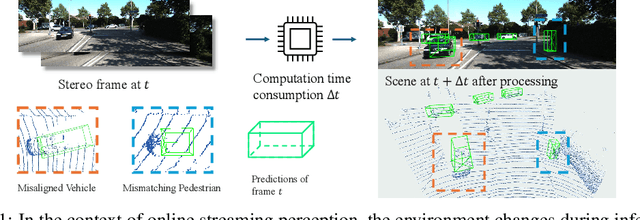
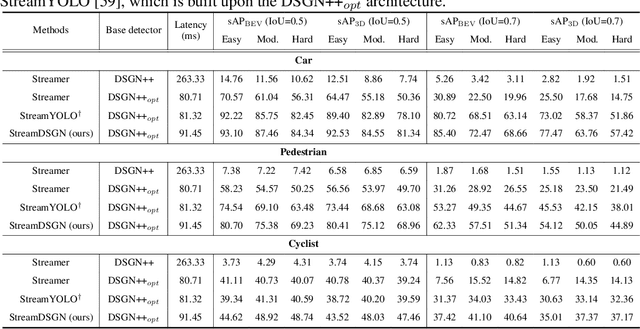
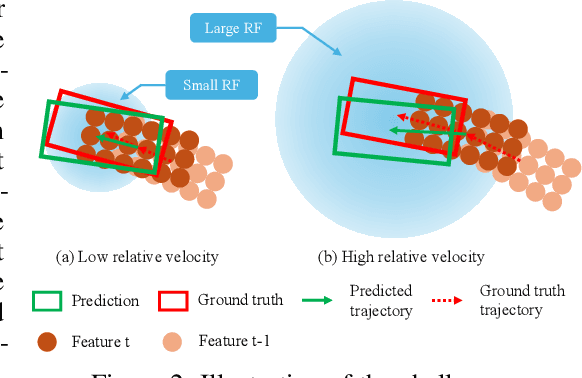
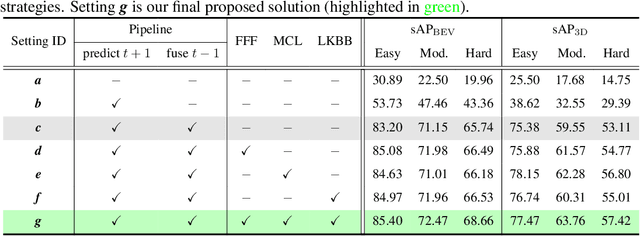
Abstract:The ability to promptly respond to environmental changes is crucial for the perception system of autonomous driving. Recently, a new task called streaming perception was proposed. It jointly evaluate the latency and accuracy into a single metric for video online perception. In this work, we introduce StreamDSGN, the first real-time stereo-based 3D object detection framework designed for streaming perception. StreamDSGN is an end-to-end framework that directly predicts the 3D properties of objects in the next moment by leveraging historical information, thereby alleviating the accuracy degradation of streaming perception. Further, StreamDSGN applies three strategies to enhance the perception accuracy: (1) A feature-flow-based fusion method, which generates a pseudo-next feature at the current moment to address the misalignment issue between feature and ground truth. (2) An extra regression loss for explicit supervision of object motion consistency in consecutive frames. (3) A large kernel backbone with a large receptive field for effectively capturing long-range spatial contextual features caused by changes in object positions. Experiments on the KITTI Tracking dataset show that, compared with the strong baseline, StreamDSGN significantly improves the streaming average precision by up to 4.33%. Our code is available at https://github.com/weiyangdaren/streamDSGN-pytorch.
Relational Diffusion Distillation for Efficient Image Generation
Oct 10, 2024
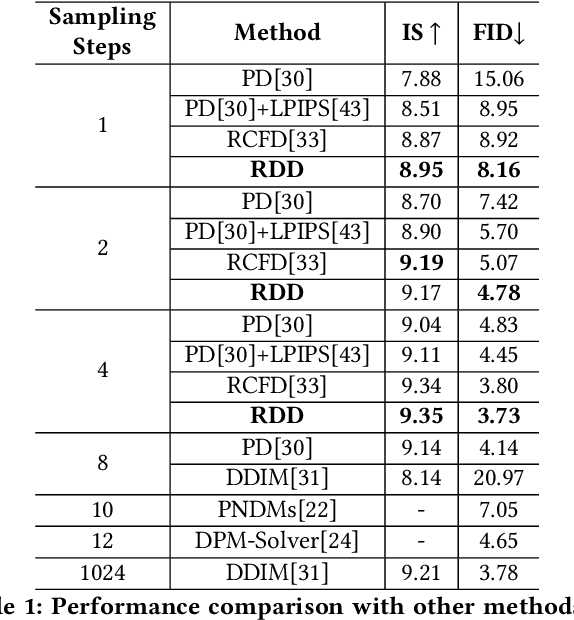
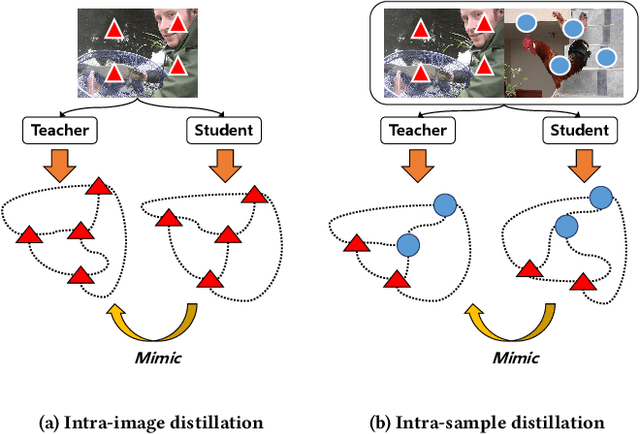
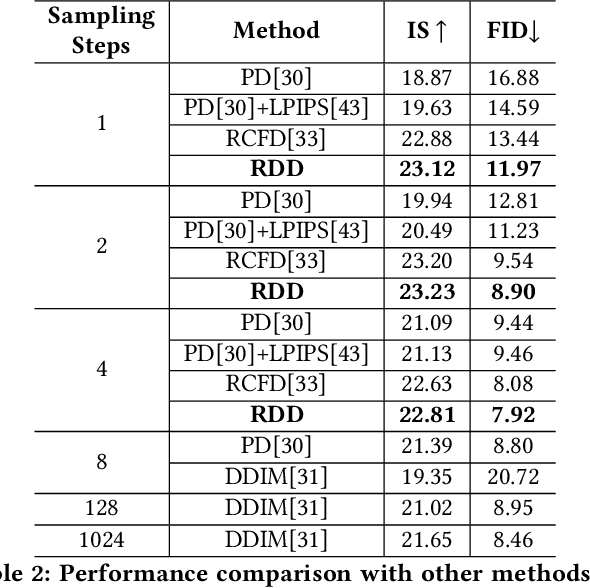
Abstract:Although the diffusion model has achieved remarkable performance in the field of image generation, its high inference delay hinders its wide application in edge devices with scarce computing resources. Therefore, many training-free sampling methods have been proposed to reduce the number of sampling steps required for diffusion models. However, they perform poorly under a very small number of sampling steps. Thanks to the emergence of knowledge distillation technology, the existing training scheme methods have achieved excellent results at very low step numbers. However, the current methods mainly focus on designing novel diffusion model sampling methods with knowledge distillation. How to transfer better diffusion knowledge from teacher models is a more valuable problem but rarely studied. Therefore, we propose Relational Diffusion Distillation (RDD), a novel distillation method tailored specifically for distilling diffusion models. Unlike existing methods that simply align teacher and student models at pixel level or feature distributions, our method introduces cross-sample relationship interaction during the distillation process and alleviates the memory constraints induced by multiple sample interactions. Our RDD significantly enhances the effectiveness of the progressive distillation framework within the diffusion model. Extensive experiments on several datasets (e.g., CIFAR-10 and ImageNet) demonstrate that our proposed RDD leads to 1.47 FID decrease under 1 sampling step compared to state-of-the-art diffusion distillation methods and achieving 256x speed-up compared to DDIM strategy. Code is available at https://github.com/cantbebetter2/RDD.
 Add to Chrome
Add to Chrome Add to Firefox
Add to Firefox Add to Edge
Add to Edge